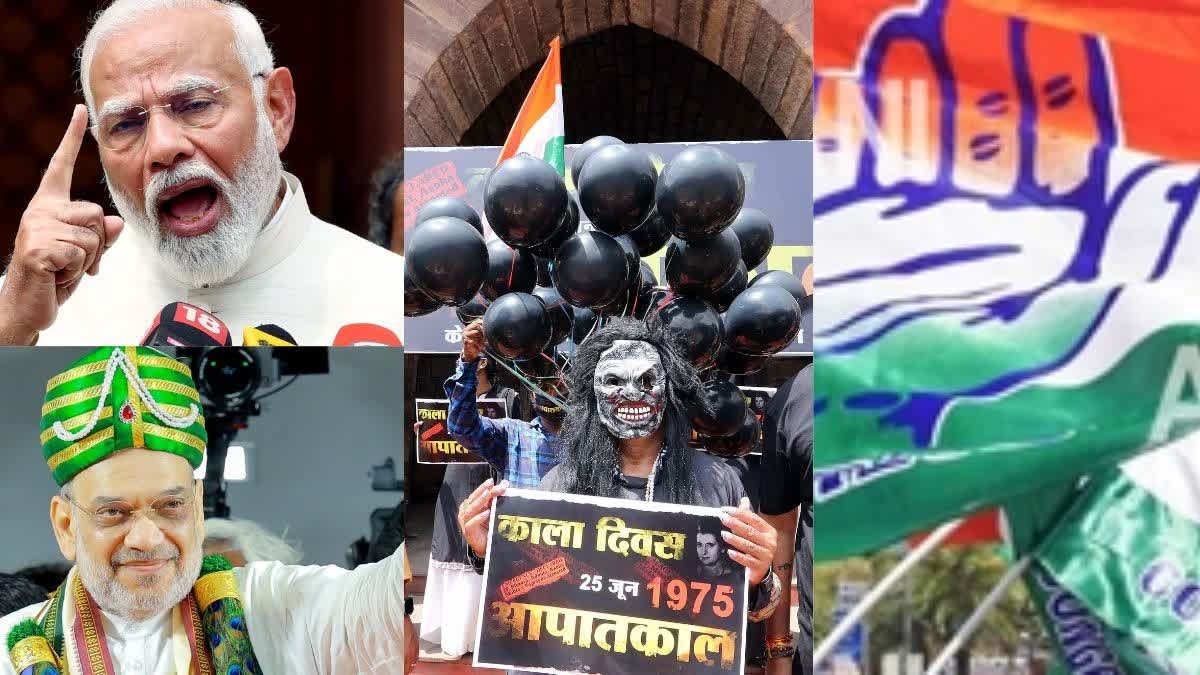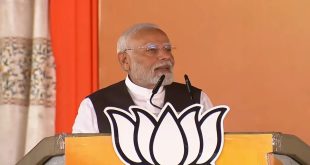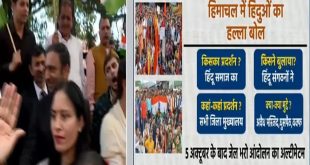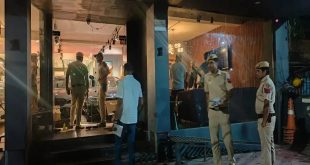 50 Years Emergency: On this day, 25 June 1975, an Emergency was imposed in the country. PM was Indira Gandhi and President was Fakhruddin Ali Ahmed. The current BJP government is cornering Congress today. BJP is celebrating Black Day today. In such a situation, read the inside story of Emergency.
50 Years Emergency: On this day, 25 June 1975, an Emergency was imposed in the country. PM was Indira Gandhi and President was Fakhruddin Ali Ahmed. The current BJP government is cornering Congress today. BJP is celebrating Black Day today. In such a situation, read the inside story of Emergency.
1975 Emergency: The opposition had no idea what was about to happen. Jyotirmoy Basu, a veteran Marxist, had pretty much guessed it when he publicly said that Mrs Gandhi wanted to abolish the Constitution, and someone close to the PM had hinted at strong action. He had installed iron bars on the windows of his house. Former Chief Minister of Orissa and BJD leader Biju Patnaik felt that a plan had been prepared and expressed his fear. But no opposition leader believed him. His words were so imaginary that no one could believe them.
Anyway, the opposition leaders were busy preparing for the June 25 rally. The rally was postponed by a day as J.P., now known as ‘Loknayak’, was late in coming to Delhi. It was the biggest rally ever held in Delhi, but not as big as Mrs Gandhi’s rally, and her supporters took all the credit for it. But the people who attended J.P.’s rally came on their own. They were not brought in trucks hired by the government. It was not a hired crowd.
One after another, opposition leaders attacked the prime minister for clinging to power. Some said she had become a dictator. They made it clear they would not let her work. J.P. announced the formation of a five-member Lok Sangharsh Samiti, with Morarji as its president and Jan Sangh stalwart Nanaji Deshmukh as its secretary. The committee would hold a nationwide agitation on the 29th to force Mrs Gandhi to resign. The agitation was to include non-violent strikes, satyagrahas and demonstrations.
JP asked the people present to raise their hands and say if necessary, they would go to jail to re-establish moral values in the country. Everyone raised their hands. Surprisingly, after 24 hours, many of them did not even protest. When the call for protest was given, the number of people going to jail decreased further. JP also appealed to the police and the army not to follow any illegal orders, as their manual also says.
Ironically, a similar appeal was made by the Congress Party in the 1930s. Motilal Nehru, Mrs Gandhi’s grandfather, persuaded the party to pass a resolution asking the police not to obey illegal orders. At that time, the Allahabad High Court had reprinted the resolution and accepted the appeal made by those who had distributed the pamphlets. The judges of the British Raj had said that there was nothing wrong in appealing to the police not to obey illegal orders.
However, for Mrs Gandhi, Sanjay and their supporters, JP’s appeal to the police and army was the biggest propaganda issue at their disposal. They could now say that he was inciting discontent among the armed forces. According to them, this was tantamount to treason.
There was commotion at PM’s residence at midnight
But this was just a pretext. Long before that, Sanjay Gandhi and his trusted men had been preparing for the attack. As the clock struck midnight, there was a great commotion at the Prime Minister’s residence. Orders had been issued to the states, and many of them wanted to know whether they had to arrest Mrs Gandhi’s opponents besides curtailing freedom of the press. Lists of leaders to be detained in Delhi and elsewhere were prepared and shown to Mrs Gandhi. The one intelligence agency that contributed significantly to the preparation of these lists was the Research and Analysis Wing (RAW).
Important role of RAW
RAW was formed in 1962 during the final stages of the war with the Chinese to improve India’s intelligence gathering abroad after the war with China had seen a massive intelligence failure. Biju Patnaik initially helped as he had a reputation for working behind enemy lines. Years earlier, when Indonesia was under Dutch rule, he had personally flown a plane to Jakarta to rescue Indonesia’s nationalist leader Sukarno during the Indonesian National Movement.
RAW was directly under the Prime Minister’s Secretariat. Mrs Gandhi was the first Prime Minister to use it for political intelligence within the country. Its hallmarks were its secrecy and its staff, who were chosen either on the basis of their stellar academic record or close links to a trusted top civil or police officer. RAW prepared dossiers on opponents of the government, critics within the Congress party, businessmen and journalists. It was not difficult to prepare a list of opponents, RAW had everything ready in its files.
The Maintenance of Internal Security Act (MISA) had been amended only a year earlier, giving the government the power to detain or arrest individuals without having to bring charges before a court. However, when the law was passed, the government had assured the opposition in Parliament that MISA would not be used to arrest political opponents. Bansi Lal wanted the leaders arrested in Delhi to be kept in Haryana. He told Mrs Gandhi, ‘I have built a big and modern jail in Rohtak.’
Indira Gandhi called the Army Chief
Mrs Gandhi called back Army Chief General Raina from his tour. This was just a precautionary step. By this time the top officers of Delhi Police also knew that JP, Morarji, Congress (O) President Ashok Mehta and two Jan Sangh leaders Atal Bihari Vajpayee and Lal Krishna Advani were also to be arrested.
But under which law? This question arose because they did not know about the emergency till then. They were trying to find out how they could be arrested. They were told that it was under section 107 of the IPC. But that applies to vagabonds. How could J.P. and Morarji be arrested under that section?
With the help of Kishan Chand, the list of names from Delhi was being finalised. When the police demanded arrest warrants, Delhi Deputy Commissioner Sushil Kumar insisted on knowing the names first. When Dhawan was informed of this, he became furious and screamed so loudly that he cowered. Then Sushil signed the blank warrants. A trusted police officer P.S. Bhinder was brought from Haryana and posted in the Special (Intelligence) Branch. He filled in the names on every warrant or used to fill them in when required.
I knew what was going to happen
In states where the chief ministers knew what was going to happen, they sat down with their respective police IGs and chief secretaries and finalised the list of those to be arrested. Though the initial preparations for this had begun on June 20, with the return of the chief ministers from Delhi, there was little doubt till then. It was assumed that some would be picked up and detained for some time to silence them.
Whenever the Chief Ministers had any questions, they would call the Prime Minister’s residence, which was called ‘ghar’ or ‘mahal’. Dhawan was on the other end and would answer all their questions. Some Chief Ministers were still unable to understand why there was a need for a new emergency when the old one was in force. Dhawan explained to them the difference between the two.
Sample of FIR made in UP
In U.P., a sample FIR was prepared by the police headquarters in Lucknow and sent to all police stations to be kept in their files. This was a precaution, although everyone knew that arrests could be made under MISA without giving any reason.
Siddharth was the only Chief Minister who was staying in Delhi and giving instructions to the officers sitting in Calcutta over the phone. Mrs. Gandhi had asked him to stay so that Siddharth could be with her when she asked the President to sign the order to impose emergency.
Siddhartha and Indira left to meet the President
About four hours before the deadline, he and Mrs Gandhi left for Rashtrapati Bhavan. Siddhartha took about 45 minutes to explain what the emergency would mean. It did not take long for the President to understand the implications. He too had once practised law. He had also got a hint from one of his assistants, K.L. Dhawan, whose brother was posted at the PM House, about what was going to happen.
He never thought of protesting. He was indebted to Mrs Gandhi for putting him in the highest office in the country. The two were close friends, especially since the time when he, along with Jagjivan Ram, wrote to the then Congress Party President S. Nijalingappa, protesting why he had sought support from the Jan Sangh and the right-wing independent parties for Sanjiva Reddy, the Congress Party’s official presidential candidate. Ahmed remembered how under Mrs Gandhi’s leadership he had defeated Reddy and defeated the syndicate of top Congress leaders.
Signature 15 minutes before time
The President signed the proclamation of imposition of emergency at 11:45 pm on 25 June (1975), i.e. 15 minutes before the scheduled time. Dhawan brought its draft from the PM House. That day no official of Rashtrapati Bhavan went home before 7 am. The proclamation said that there is a grave emergency situation in which the security of India is threatened by internal disturbance. It gave the government many powers including ending the freedom of the press, stopping the court proceedings related to the enforcement of civil rights.
as it happened in Germany
This was very similar to what had happened in Germany years earlier. Hitler had succeeded in convincing President Hindenburg to sign an order that would repeal those sections of the constitution that guaranteed personal and civil liberties, in order to protect the people and the country.
Now Mrs Gandhi had full power to deal with the opposition and the press that were questioning her legitimacy. She had full authority to make laws as she pleased, and also full power to change rules and traditions. A country that had somehow managed to walk on the path of democracy since independence in August 1947, while Western countries were criticising whether this system was in accordance with Indian wisdom, had now become a semi-dictatorial system.
 Suspense Crime Sach Ka Dam
Suspense Crime Sach Ka Dam


